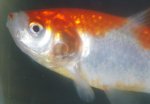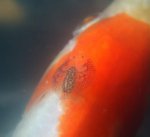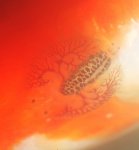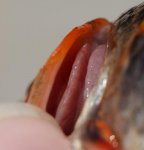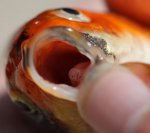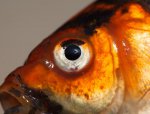A bit longwinded so you know entire story.
But TL;DR, one fish dead, some strange behaviour in fish, one fish has strange skin problem (picture attached), wondering what's going on.
So, I got a 9500 galon pond per advice of my landscaping guy, who ensured me fish keeping is easy, and fish are low maintenance (yeah, right).
The pond was completed and filled with water end of last fall, but I only started to put in fish about 1.5 months ago. Even before then I had an algae bloom that never subdued (currently I can see maybe 8 inces deep, used to be 3 inches deep).
The initial load of fish included 10 feeder 2" goldfish from petsmart, a 6 shubunkins at 3-4", 4 koi at 4", 1 large (11") buttefly goldfish, a bit later 6 more 3" koi.
Initially fish was hiding very well and I even suspected it had died, food always floating at surface uneaten, but no floaters ever appeared. I put in one water lily and feeder goldfish started to hang under the leaves after a while, so I found out the fish was still there.
Then a three weeks after that I tried to feed at night with a flashlight and they came, but very afraid of the light, the big goldfish looking very lively.
I also got a camera overlooking the pond (taking a picture every 5-30 seconds) to ensure there were no predators tht would explain fish being so afraid.
Last week the big goldfish became very brave, frequently appeared at the surface even at the day time, though it looked a bit strange as I then though, yet I was happy thinking that fish finally is becoming familiar with the place.
I got 6 more 8" koi (from pond megastore this time for a change) that have arrived this Tuesday and let them into the pond at 9am. At 3:45pm I looked outside of my window and saw something white floating in the pond - turned out the big goldfish died.
(I examined the cam footage, the goldfish was astively "surverying the pond perimeter" until around 1:40pm or so, then disappeared, the dead fish floated up at 1:40pm, so I happened to see it right away).
The fish did eat the evening before at the mormal feeding time.
I don't think whatever these new koi might have on them (of course the seller assures all their fish are disease free, live in ponds that have not seen any added fish in like 60 years) would have worked as fast.
When I got the dead fish, the gills were pale green, one side outside of the gills had a lot of green growth, kind of like dense moss I would think, but I don't think I have ever seen it on the fish (but visibility is a problem, so I might have missed it easily). Sadly I did not think of taking a picture at the time. I brought the fish back to the store where I get it and they said they never have seen anything like that and exchanged it under warranty for another similar fish (hopefully not to meet it's certain death).
Now ever since I put those large koi in, they are super active they come to feed at day time too (but generally avoid the sun exposure), and other fish seems to be coming with them, a lot of original fish is much bigger now it seems, still much more skittish than the new koi. On a video footage from yesterday I see a replacement big goldfish mid-air over the pond (considering was taking pictures once every 30 seconds, that was a hell of a lucky shot or the fish was jumping all the time at the time?).
The feeder goldfish growth was uneven, some became considerably bigger, some much less so.
I noticed that some like to seclude themselves in corners of the pond or under water lily leaves, just hanging in one place, breathing fast (my my standards, anyway, like 3-4 times per second), sometimes coming to just under surface, and sometimes like catching some invisible stuff from surface.
Also I noticed today that one of the earlier koi (that like tripled in size) acts a bit strange, came to feed with the rest of the fish, but almost did not go to the surface and even when coming, did not try to get the food, but just munched water surface, seemingly missing the food that just floated above it moments ago.
Come think of it, it's hard to tell how many fish actually come to feed (due to water non-transparency), in a single picture I can make perhaps 11-12 fish bodies, I also occasionally see some distinct ones so make that 14-15, but that's still way under the number I should have in total.
Catching the fish in my pond is really hard - it's big, deep and really non-transparent, but I managed to catch one of the feeder goldfish to examine how do the gills look like (seem to be ok, though hard to be sure with this small fish, it's one of the smaller 3" ones) and
noticed one one side of the gill cover does not look right, there's non shiny patch with like the surface scratched off, there's no blood or red, I made a picture that hopefully shows this thing good enough, and I have no idea what that is.
Also tonight I came out with a flashlight and noticed the strangely-behaving koi from before is hanging just under the place where I administer food and not deeply, so I can still see the static fish when I shine my flashlight into the water.
It did not care for the net (usually as soon as net is in the water, all fish disappeares hiding) until the moment I lifted it out of water where it understandably became super worried. I examined it and don't see anything wrong, if only a bit of redness at the root of left front fin, but that might just be the natural color. I let it back into the pond for now as I don't have anywhere to isolate it, but the smaller goldfish with side damage is in a bucket for now until I decide what to do, probably need to catch a couple more for examination.
So now I am worrying if I have something in my pond that will kill all the other fish over time? Or not?
I check water parameters weekly, I have 0 ammonia, zero nitrates and nitrites, ph of 8.2 in the morning-8.4 in the evening, kH hardness of about 90, zero phosphates, zero chlorine.
I also have tons of foam (organics overload from leaves at the bottom from last fall?) and the foam amount increased significantly yesterday.
I should have plenty of aeration - there's a stream with multiple waterfalls that's 18' elevation (and that should work as a trickle tower apparently too, I don't have a separate filter).
But TL;DR, one fish dead, some strange behaviour in fish, one fish has strange skin problem (picture attached), wondering what's going on.
So, I got a 9500 galon pond per advice of my landscaping guy, who ensured me fish keeping is easy, and fish are low maintenance (yeah, right).
The pond was completed and filled with water end of last fall, but I only started to put in fish about 1.5 months ago. Even before then I had an algae bloom that never subdued (currently I can see maybe 8 inces deep, used to be 3 inches deep).
The initial load of fish included 10 feeder 2" goldfish from petsmart, a 6 shubunkins at 3-4", 4 koi at 4", 1 large (11") buttefly goldfish, a bit later 6 more 3" koi.
Initially fish was hiding very well and I even suspected it had died, food always floating at surface uneaten, but no floaters ever appeared. I put in one water lily and feeder goldfish started to hang under the leaves after a while, so I found out the fish was still there.
Then a three weeks after that I tried to feed at night with a flashlight and they came, but very afraid of the light, the big goldfish looking very lively.
I also got a camera overlooking the pond (taking a picture every 5-30 seconds) to ensure there were no predators tht would explain fish being so afraid.
Last week the big goldfish became very brave, frequently appeared at the surface even at the day time, though it looked a bit strange as I then though, yet I was happy thinking that fish finally is becoming familiar with the place.
I got 6 more 8" koi (from pond megastore this time for a change) that have arrived this Tuesday and let them into the pond at 9am. At 3:45pm I looked outside of my window and saw something white floating in the pond - turned out the big goldfish died.
(I examined the cam footage, the goldfish was astively "surverying the pond perimeter" until around 1:40pm or so, then disappeared, the dead fish floated up at 1:40pm, so I happened to see it right away).
The fish did eat the evening before at the mormal feeding time.
I don't think whatever these new koi might have on them (of course the seller assures all their fish are disease free, live in ponds that have not seen any added fish in like 60 years) would have worked as fast.
When I got the dead fish, the gills were pale green, one side outside of the gills had a lot of green growth, kind of like dense moss I would think, but I don't think I have ever seen it on the fish (but visibility is a problem, so I might have missed it easily). Sadly I did not think of taking a picture at the time. I brought the fish back to the store where I get it and they said they never have seen anything like that and exchanged it under warranty for another similar fish (hopefully not to meet it's certain death).
Now ever since I put those large koi in, they are super active they come to feed at day time too (but generally avoid the sun exposure), and other fish seems to be coming with them, a lot of original fish is much bigger now it seems, still much more skittish than the new koi. On a video footage from yesterday I see a replacement big goldfish mid-air over the pond (considering was taking pictures once every 30 seconds, that was a hell of a lucky shot or the fish was jumping all the time at the time?).
The feeder goldfish growth was uneven, some became considerably bigger, some much less so.
I noticed that some like to seclude themselves in corners of the pond or under water lily leaves, just hanging in one place, breathing fast (my my standards, anyway, like 3-4 times per second), sometimes coming to just under surface, and sometimes like catching some invisible stuff from surface.
Also I noticed today that one of the earlier koi (that like tripled in size) acts a bit strange, came to feed with the rest of the fish, but almost did not go to the surface and even when coming, did not try to get the food, but just munched water surface, seemingly missing the food that just floated above it moments ago.
Come think of it, it's hard to tell how many fish actually come to feed (due to water non-transparency), in a single picture I can make perhaps 11-12 fish bodies, I also occasionally see some distinct ones so make that 14-15, but that's still way under the number I should have in total.
Catching the fish in my pond is really hard - it's big, deep and really non-transparent, but I managed to catch one of the feeder goldfish to examine how do the gills look like (seem to be ok, though hard to be sure with this small fish, it's one of the smaller 3" ones) and
noticed one one side of the gill cover does not look right, there's non shiny patch with like the surface scratched off, there's no blood or red, I made a picture that hopefully shows this thing good enough, and I have no idea what that is.
Also tonight I came out with a flashlight and noticed the strangely-behaving koi from before is hanging just under the place where I administer food and not deeply, so I can still see the static fish when I shine my flashlight into the water.
It did not care for the net (usually as soon as net is in the water, all fish disappeares hiding) until the moment I lifted it out of water where it understandably became super worried. I examined it and don't see anything wrong, if only a bit of redness at the root of left front fin, but that might just be the natural color. I let it back into the pond for now as I don't have anywhere to isolate it, but the smaller goldfish with side damage is in a bucket for now until I decide what to do, probably need to catch a couple more for examination.
So now I am worrying if I have something in my pond that will kill all the other fish over time? Or not?
I check water parameters weekly, I have 0 ammonia, zero nitrates and nitrites, ph of 8.2 in the morning-8.4 in the evening, kH hardness of about 90, zero phosphates, zero chlorine.
I also have tons of foam (organics overload from leaves at the bottom from last fall?) and the foam amount increased significantly yesterday.
I should have plenty of aeration - there's a stream with multiple waterfalls that's 18' elevation (and that should work as a trickle tower apparently too, I don't have a separate filter).

